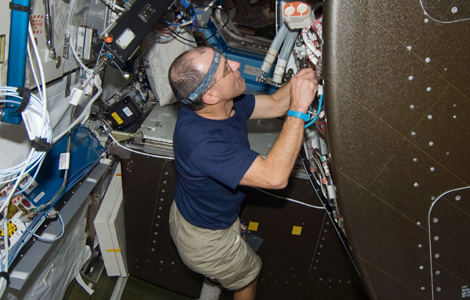Our Fancy Coffee Machine
When it comes to recycling water, space station astronauts are on the frontier.
During the flight of STS-126 in 2008, we carried up three refrigerator-sized pieces of equipment. One was a toilet for the NASA side of space station. There was already one on the Russian side, so this one gave us redundancy. In the past, when the toilet broke, all work halted until we fixed it. No other single piece of equipment fell into this category of importance. The oxygen generator could break, and maybe in a day or two we would fix it; same with the carbon dioxide scrubber. But when the toilet broke—now that was serious.
The second piece of equipment we carried up was a small chemical plant. It contained a distillation apparatus, catalytic reactors, pumps, filters, and plumbing. It was a chemical engineer’s dream. The liquid effluent from the toilet was plumbed to the inlet of this machine.
The third piece of equipment was a new galley. It sported an injection port for filling our drink bags and rehydrating freeze-dried food with our choice of hot or room-temperature water. It also had a hot box for warming thermally stabilized meat pouches (canned meat without the can) and a small refrigerator—not for science samples, but for the crew’s food. The inlet to the galley was plumbed into the outlet of the chemical plant. This completed what we call our regenerative life support system. Simply put, what goes out one end is processed, reworked, and put back in the other end.
Water is an essential ingredient not just for us, but for all life forms that we recognize. And water is always in short supply on a spacecraft. There may be water shortages in some places on Earth, but spaceflight redefines the meaning of the word “desert.” Closing the water loop will therefore be essential technology when humans venture away from Earth for long periods of time. If the toilet fails on a mission to Mars, the crew will run out of water and die. Earth orbit, where spare parts and engineering knowledge are close by, is the ideal place to refine this technology and produce equipment that is truly robust. I call this engineering research; it is complementary to scientific research, and is one of the more important activities that we conduct on space station.
Nowhere on Earth do we recycle urine using portable machinery. Not in Antarctica, not on ships at sea, not in our driest deserts. We choose to let Earth do the recycling, not a machine. Our recycling system on space station is not a one-time demonstration, nor a test of astronauts’ ability to handle the “yuck factor.” It’s a day-in, day-out operation, designed as an integral part of the overall spacecraft water balance. With this technology, we are truly on the frontier, and we have serial number 001 of a complex machine. Of course it breaks down—constantly. And of course, we are always fixing it. Of course there is a steady stream of spare parts arriving from Earth. Any new technology is like this. The first crews arriving at Mars will thank us for our urine-stained hands.
Morning is a time for comfortable habits, and so it is on space station. Each morning I float out (“getting up” is obviously a gravity-centric expression) and do my daily routine. I can hear the rumbles of the chemical plant. It vibrates the deck rails and gives your feet a massage at the same time. Then I float over to the galley and make a bag of coffee. Kona is one of my favorites; I can feel the caffeine race to my brain and stimulate my thoughts. It occurs to me that our regenerative life support equipment is really just a fancy coffee machine. It makes yesterday’s coffee into today’s coffee.
/https://tf-cmsv2-smithsonianmag-media.s3.amazonaws.com/accounts/headshot/Pettit_in_Star_City.JPG)

/https://tf-cmsv2-smithsonianmag-media.s3.amazonaws.com/accounts/headshot/Pettit_in_Star_City.JPG)